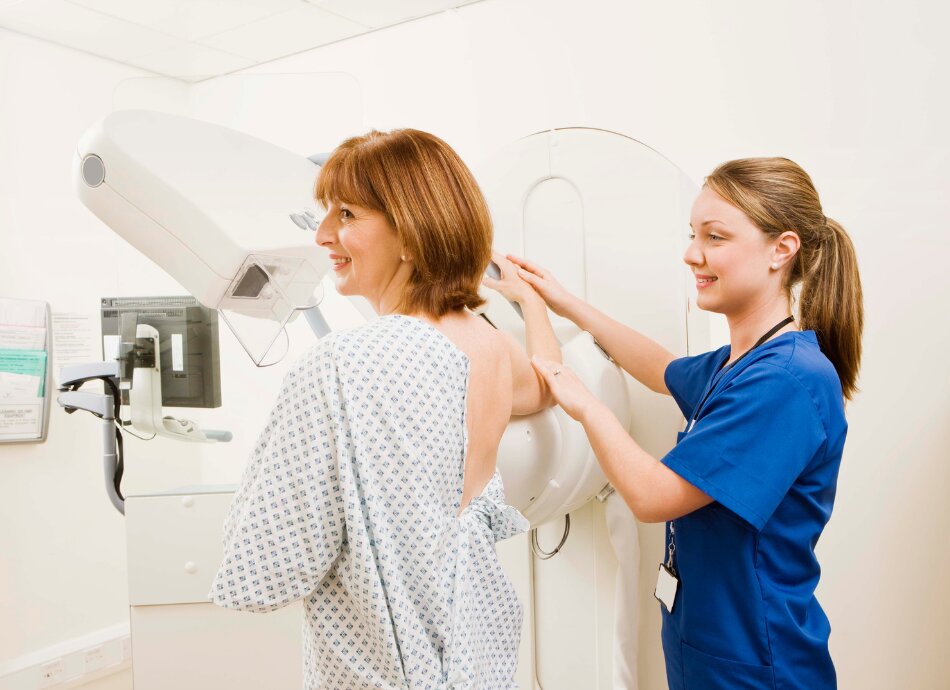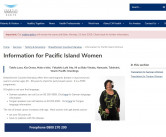There are 2 different types of mammograms – 2D or 3D mammograms. A 2D mammogram takes a picture of your breast from the front and from the side and these are combined to create a single image. 3D mammograms take many pictures of your breast from different angles to show the breast tissue in more detail.
Low or no data? Visit zero.govt.nz, scroll down the page then click on our logo to return to our site and browse for free.
Mammogram
Also known as breast tomosynthesis
Key points about mammogram
- A mammogram is a low-dose X-ray of your breast tissue.
- It can be done in 2D or 3D and is used to detect small cancers at an early stage when there's a good chance of successful treatment.
- It can show abnormalities in your breasts before anything can be seen or felt.
- In Aotearoa New Zealand breast screening mammograms are free for women from 45–69 years of age.

A mammogram, either 2D or 3D, is the best available test to detect small cancers at an early stage when there is a very good chance of successful treatment. It can show changes and abnormalities in your breasts before anything can be seen or felt.
You may have a mammogram because you have noticed something different about your breasts, or you may have it as part of regular 2 yearly screening for breast cancer.
Having a mammogram cannot prevent you from developing breast cancer, but it can increase your chance of successful treatment if you do develop breast cancer. Because mammograms can pick up breast cancer early, they are thought to reduce your chance of dying from breast cancer by about a third.
Mammograms are better at picking up breast cancer in women over the age of 50. This is because their breast tissue is less dense than women under the age of 50. This means the mammogram will show more.
- Mammograms can detect about 75% of unsuspected cancers in women under 50 and 85% in women over 50.
- Mammograms are most effective at detecting breast cancers in women over 50 if they are done every 2 years. This is because they can track any changes over time.
- Either type of mammogram is safe because only very small amounts of radiation are used.
It is recommended that all women aged 45 and over have screening mammograms every 2 years. In New Zealand, you are able to have a free mammogram every 2 years if you are aged between 45 and 69 years. Book this through BreastScreen Aotearoa(external link) (freephone 0800 270 200). This program is not available to you if you do not qualify for publicly funded healthcare in Aotearoa New Zealand and if you do not live in New Zealand. Check with your family doctor for options.
What if I am under 45?
If you are under the age of 45 you can have mammograms if you have a high risk of developing breast cancer. The high risk factors are:
- You have previously had previous breast cancer.
- Your mother or sister developed breast cancer before menopause or had breast cancer in both breasts.
- You have had a breast biopsy and the results indicated that you have a lump or area at high risk of developing a cancer – an ‘at-risk lesion’.
If you are in this group of high risk women you may be referred to a surgeon who may recommend a different type of breast screening such as an MRI. If you do have a mammogram it will be done through a hospital radiology service, not BreastScreen Aotearoa. If you think you are in this high risk group talk to your family doctor.
Like other screening tests, mammograms are not perfect.
- A mammogram may suggest that something is not right when, in fact, all is well. This is called a false positive result.
- Some cancers do not show up on a mammogram. This is more likely to happen in younger women before menopause who often have dense breast tissue.
- The radiologists looking at the mammogram may miss the cancer. This will happen sometimes, no matter how experienced the radiologist and team are.
- Some breast cancers are fast growing and can develop between regular mammograms.
Despite this, mammograms are a proven way of finding breast cancers early enough to reduce your risk of dying of breast cancer. Particularly for women over the age of 50.
Because a mammogram may miss a breast cancer, or a cancer can develop between your mammograms, it is important to know your breasts and look at them regularly. This is easy to do. Find out how to do it by watching the video below.
Video: Checked your breasts lately? We'll show you how
This video may take a few moments to load.
(Breast Cancer Foundation NZ, 2015)
Regular mammograms reduce the chance of dying from breast cancer among women aged 45 to 69. However, the benefit is greatest for women aged 50 to 69 years for two reasons:
- Breast tissue is denser in women under 50. This can make it more difficult to see a cancer. Because of this about a quarter of cancers in women under 50 years are not detected.
- False positive results are also more common in younger women (under 50) and could lead to more unnecessary tests and anxiety.
Because you will need to undress from the waist up, wear clothing that is easy to remove, such as a blouse or jersey. A cape or gown will be available where you have your mammogram and your privacy will be protected as much as possible.
Don't use talcum powder, creams or deodorants on the day of your mammogram as these make cancers harder to find on the mammogram.
You may wish to bring:
- any previous mammograms results if you have them
- your glasses if you need them for reading as you will need to fill in a form
- a support person or member of your whānau.
During the procedure, each breast in turn is held between plates on the mammography machine while the pictures are taken. While this may be uncomfortable, it only takes a few seconds for each picture to be taken.
Video: Watch Stacey have her mammogram
This video may take a few moments to load.
(Breast Cancer Foundation, NZ, 2020)
The radiographer will want you to be as comfortable as possible so discuss any concerns with them.
The whole visit, including waiting time and breast screening time, is usually about 30 minutes.
The results of the mammogram will be sent directly to you. They will also be sent to your doctor if you have agreed to this. If an area of concern is picked up on your mammogram you will be contacted and asked to have further investigation of that area of your breast.
Only a very small amount of radiation is used in mammography so the radiation risk is extremely low.
Like many tests, there is a small false negative rate. This means mammography is not able to pick up all cases of breast cancer. Likewise, there is a false positive rate which means not all abnormal mammograms turn out to be breast cancer. Further tests will be done to find out if any breast changes detected are serious or minor.
Having regular mammograms reduces the false positive rate as the radiologist reading your X-ray will be able to compare it to your previous mammograms to identify any changes.
BreastScreen Aotearoa(external link) TimetoScreen, National Screening Unit, (Freephone 0800270200).
Enrol online for a free breast screening mammogram(external link) Breast Screen Aotearoa, TimetoScreen, National Screening Unit
Breast cancer(external link) Te Aho o Te Kahu | Cancer Control Agency NZ
Information for women under 45(external link) Breast Screen Aotearoa, NZ
Resources
Having a mammogram(external link) HealthEd, NZ, 2022 Available in the following languages: English(external link), Tongan(external link), Chinese (simplified)(external link), Hindi(external link), Japanese(external link), Korean(external link), Sign language(external link), Thai(external link)
Information for Pacific Island women(external link) Health New Zealand | Te Whatu Ora Counties Manukau
Translation for Samoan Women(external link)
Translation for Tongan Women(external link)
References
Mammogram(external link) Mayo Clinic, US, 2022
Breast imaging – screening(external link) Community Health Pathways, Whanganui & MidCentral, NZ
Having a mammogram(external link) Breast Cancer Foundation, NZ
Mammography(external link) Breast Institute NZ
Breast health podcast,(external link) Dr Erica Whineray Kelly an oncoplastic breast cancer surgeon in Auckland. Goodfellow Unit, 2019
iPrevent Resources for clinicians Peter MacCallum Cancer Centre(external link) Victoria Australia
Information about mammography for health professionals(external link) InsideRadiology RANZCR
Increasing the uptake of breast screening(external link) BPAC, NZ, 2011
Breast screening – achieving equity(external link) BPAC, NZ, 2009
Brochures
Having a mammogram
HealthEd, NZ, 2022
English, Tongan, Chinese (simplified), Hindi, Japanese, Korean, Sign language, Thai
Information for Pacific Island women
Health New Zealand | Te Whatu Ora Counties Manukau
Translation for Samoan Women, Translation for Tongan Women
Credits: Healthify editorial team. Healthify is brought to you by Health Navigator Charitable Trust.
Reviewed by: Healthify Editorial Team
Last reviewed:
Page last updated:







